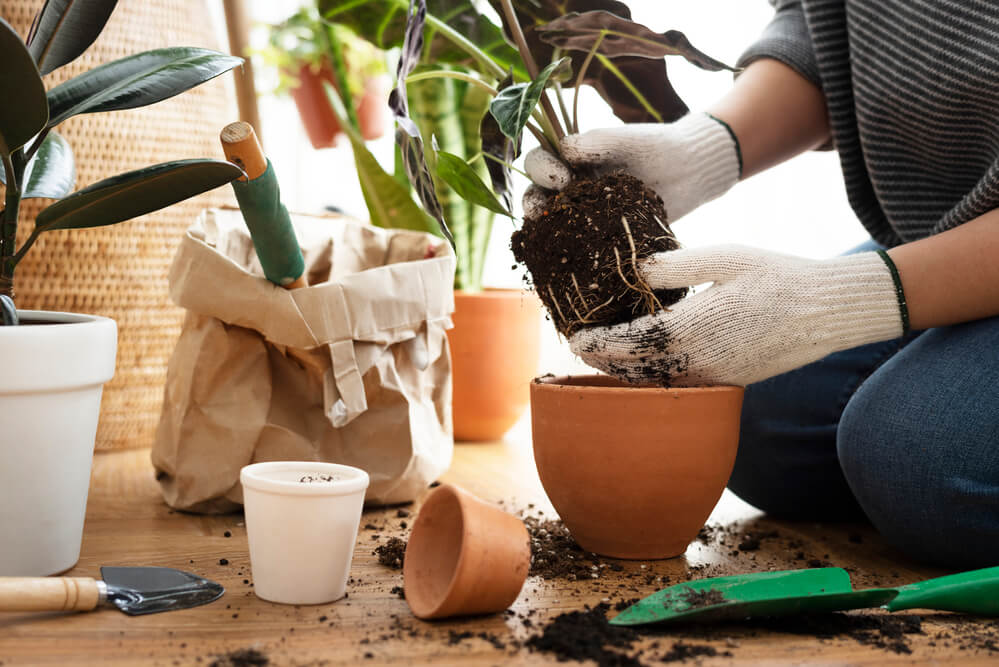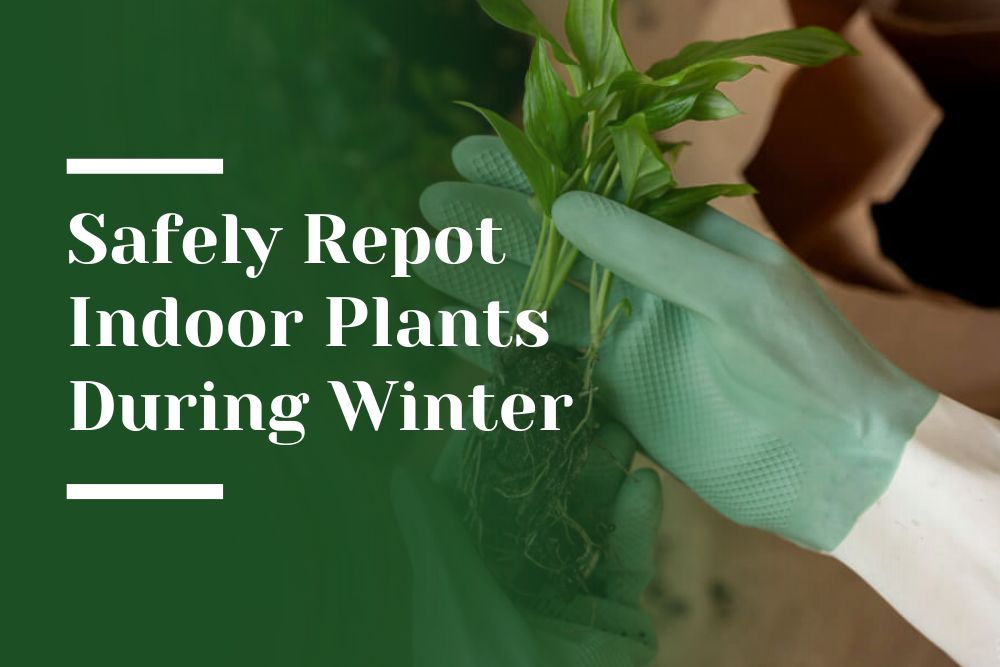Winter is a time when plants, much like humans, slow down and conserve energy. Many indoor plants enter a dormant phase during the colder months, making it a prime time to consider repotting. According to expert landscape designer Ward Dilmore, transplanting and repotting plants in winter can actually be less stressful for the plants compared to other seasons, as their reduced growth allows them to adjust to new soil and containers more easily.
We’ll cover the benefits of winter repotting, why winter can be preferable over spring for this task, the difference between repotting and transplanting, and step-by-step instructions for safely repotting your indoor plants in winter. Additionally, we’ll discuss specific care tips for people living in the Bay Area, as the mild winter climate there can affect the process.
Why Winter is the Best Time for Repotting
During the winter, plants go dormant, meaning they halt active growth and focus on maintaining only their essential systems. In this dormant state, plants are not producing new leaves, flowers, or roots, which makes them less susceptible to the shock of being moved to new soil or a different pot. This is a distinct advantage when repotting, especially in luxury landscaping, where plant health and aesthetic integration are key. By repotting in winter, plants can adapt to their new environment without the added strain of growth demands, allowing for a smoother transition and ultimately contributing to a more resilient and beautiful landscape design.
Is Repotting Safe in Winter?
Yes, repotting is generally safe in winter, especially for indoor plants that do not experience extreme temperature changes. When done properly, winter repotting can even benefit plants by providing them with fresh soil and nutrients in preparation for the upcoming growing season.
While it’s true that many gardeners prefer to repot in spring, winter repotting can be just as effective, if not more so, for specific plant types and situations. During winter, when plants are dormant, they are naturally more resilient to changes. This period of dormancy allows them to adjust gradually to new conditions without the stress of active growth. Incorporating winter repotting into your garden design strategy can ensure healthier plants come spring, as they have ample time to establish in fresh soil and adjust to their new environment.

Is Spring Better Than Winter for Repotting?
Spring is often seen as the traditional time for repotting because plants are beginning to grow actively and will quickly expand into their new space. However, spring repotting can sometimes be stressful for plants that are already investing energy into new growth. Repotting in winter, on the other hand, allows plants to settle in a new pot or soil without the added demands of active growth. This can be particularly beneficial for plants that are prone to transplant shock or have delicate root systems.
That said, there are some plants, especially tropical varieties, that might benefit more from spring repotting. Always consider your plant’s specific needs and growth habits when choosing the best season to repot.
What is Transplanting?
Transplanting and repotting are terms that are often used interchangeably, but they refer to slightly different processes:
Repotting: Moving a plant to a larger pot or refreshing its soil within the same pot.
Transplanting: Moving a plant from one location to another, which could be within the same pot, a different pot, or even outdoors if climate permits.
Transplanting is typically a more involved process than simple repotting and may be necessary for larger plants or those that are particularly root-bound. Like repotting, transplanting is also less stressful during the dormant period in winter.
Why Consider Transplanting in Winter Rather Than Repotting?
For some plants, especially those that have become root-bound or suffer from poor soil conditions, transplanting might be more effective than repotting. During winter dormancy, transplanting becomes a gentler process as plants are not actively growing, which reduces the risk of shock. By moving plants to new soil or a larger space in winter, you’re giving them ample time to adjust before they begin to grow again in spring.

Benefits of Repotting vs. Transplanting in Winter
Winter is a great time to give your plants a fresh start, whether through repotting or transplanting. During the dormant period, plants slow down, which means they need fewer resources and can adjust to new surroundings more easily. Here’s a closer look at the benefits of each approach:
Less Stress for the Plant: During winter dormancy, plants aren’t focused on producing new growth. This is ideal for both repotting and transplanting, as plants can adapt to new pots or locations without the added energy demand of growing leaves, flowers, or roots. Repotting or transplanting during this time minimizes the stress that plants would experience if they were actively growing.
Healthier Roots: Repotting gives your plants fresh soil, which can help clear up issues that may have built up over time, like root rot, pests, and nutrient deficiencies. When repotting, you can examine the roots, trimming away any dead or diseased parts. This encourages healthier root growth as the plant prepares for spring.
Improved Drainage: Winter is the perfect time to ensure that your plants have proper drainage. By choosing the right potting mix and a pot with adequate drainage holes, you can help prevent problems like waterlogging and root rot. This improved drainage will be especially helpful in supporting healthy growth when the plant starts to wake up in the spring.
Head Start for Spring Growth: Repotting in winter allows your plants to adjust to their new environment well before the growing season begins. This way, when spring arrives, your plants are already settled in, giving them a strong head start for rapid growth. They’ll be ready to absorb nutrients and produce new foliage without delay.
Soil Rejuvenation: Fresh soil provides essential nutrients and a better soil structure, which is especially important as plants begin to grow again in spring. Over time, soil can become compacted or depleted of nutrients, which limits the plant’s ability to absorb water and nutrients. By repotting in winter, you’re giving the plant a fresh medium that promotes healthier growth in the upcoming seasons.
Step-by-Step Guide for Repotting Indoor Plants in Winter
Step 1: Choose the Right Time
Repotting in late fall or early winter, just before the plant enters full dormancy, is ideal. In some regions, this means early November or December.
Step 2: Prepare the New Pot and Soil
Choose a pot that is only slightly larger than the current one. If you go too large, it can lead to waterlogging. Select a high-quality, well-draining potting mix suitable for your plant type.
Step 3: Water the Plant a Day Before Repotting
Giving the plant a good drink the day before makes it easier to remove from its current pot and reduces the shock of repotting.
Step 4: Remove the Plant Carefully
Loosen the plant gently and turn the pot over, supporting the plant as you slide it out. Be careful not to damage the root ball.
Step 5: Trim Dead or Damaged Roots
Use clean, sharp scissors to trim away any dead, diseased, or damaged roots. This helps to promote healthy new growth.
Step 6: Place in the New Pot
Put a layer of fresh soil at the bottom of the new pot, place the plant, and fill the sides with more soil. Gently press down to remove air pockets, but avoid compacting the soil too much.
Step 7: Water Lightly
Water sparingly, as dormant plants don’t need much water. Overwatering can lead to root rot.
Step 8: Place in a Stable Environment
Keep the plant in a stable indoor location, away from drafts or heaters. Winter sunlight is weaker, so place the plant near a well-lit window if possible.
Step 9: Monitor Regularly
Check on the plant for signs of stress or dehydration, but avoid over-watering. Adjust your care routine gradually as spring approaches.
Winter Climate in the Bay Area: Plant Care Tips
The Bay Area’s mild winter climate can make plant care easier, but it also requires some specific considerations:
- Humidity: Winter air can be dry, so consider using a humidifier to keep plants from drying out.
- Sunlight: Days are shorter in winter, so place plants near south-facing windows to maximize sunlight exposure.
- Temperature Control: Keep indoor plants away from cold drafts or heaters, which can cause temperature fluctuations.
- Avoid Overwatering: Water less frequently, as plants are dormant and require less moisture.

FAQs on Winter Repotting and Transplanting
Is it safe to repot indoor plants in winter?
Yes, repotting in winter is generally safe for indoor plants due to their dormant state.What’s the difference between repotting and transplanting?
Repotting is simply moving a plant to a larger pot, while transplanting may involve moving it to a new environment.Should I prune my plant when repotting in winter?
It’s okay to trim dead roots but avoid heavy pruning, as plants are dormant.Can I use fertilizer when repotting in winter?
No, it’s best to wait until spring to fertilize, as plants are not actively growing in winter.How often should I water repotted plants in winter?
Water sparingly, as dormant plants need less moisture.Can all indoor plants be repotted in winter?
Most can, but tropical plants may benefit more from spring repotting.How can I avoid root rot after repotting?
Ensure the pot has drainage holes and avoid overwatering.Is there an ideal soil mix for winter repotting?
A well-draining mix suited to your plant type is best to prevent waterlogging.Do plants go fully dormant indoors?
Many do, especially in cooler rooms. However, some may maintain minimal growth.When should I start spring care after winter repotting?
Gradually increase watering and start light fertilizing when new growth appears in spring.
Final Thoughts
Repotting indoor plants during winter can be a beneficial practice, especially when plants are dormant and less sensitive to environmental changes. By providing fresh soil and a new pot during the cooler months, you’re setting your plants up for a strong, healthy start in spring. For Bay Area residents, winter repotting is an excellent way to care for your indoor greenery while adapting to the region’s mild winter climate. Follow the steps and tips above to ensure that your plants stay healthy and thrive in their new homes.



